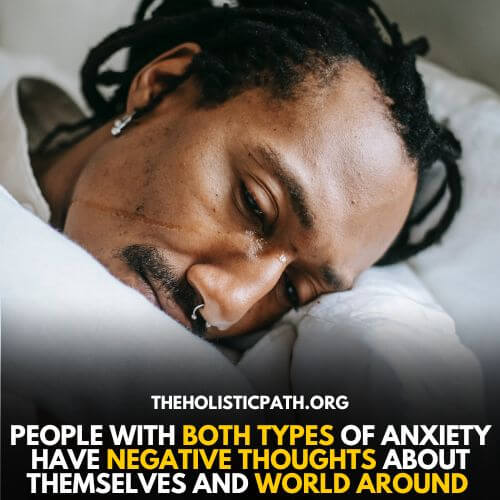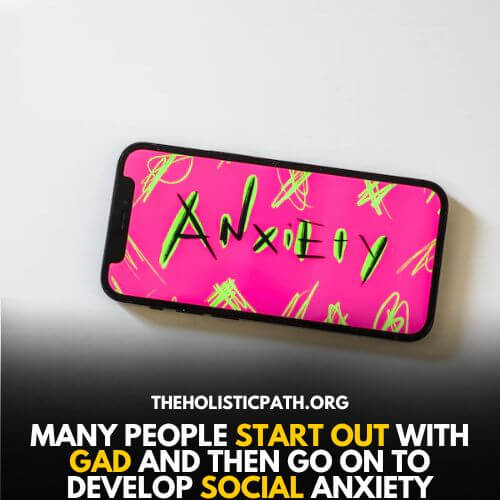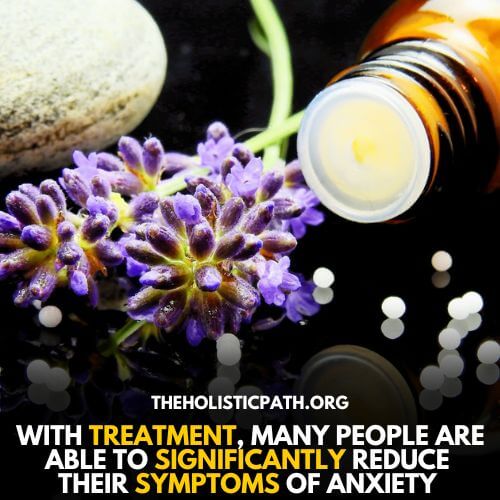Generalized anxiety vs social anxiety: what’s the difference? If you’re someone who experiences anxiety, you might be all too familiar with the different types of anxiety that exist.
Generalized anxiety and social anxiety are two of the most common types of anxiety disorders, but they often get confused with one another. So, what’s the difference between generalized anxiety and social anxiety? Let’s explore …
Introduction To Anxiety Disorders
Anxiety disorders are the most common mental health disorders in the United States. There are different types of anxiety disorders, including generalized anxiety disorder (GAD), social anxiety disorder, and panic disorder.
Symptoms of anxiety can include feeling restless or tense, having trouble sleeping, sweating, rapid heart rate, and feeling like you’re going to faint or have a heart attack.
Anxiety disorders can be caused by a variety of factors, including genetics, brain chemistry, and life experiences. Treatment for anxiety usually includes therapy and medication. If you think you might have an anxiety disorder, it’s important to see a mental health professional for diagnosis and treatment.
What Is Generalized Anxiety Disorder?
Generalized anxiety disorder (GAD) is a mental health condition characterized by feelings of worry, nervousness, and stress that are disproportionate to the situation and persist even when there’s nothing to trigger them.
People with GAD may feel like they can’t stop worrying and that their worries are out of their control. They may worry about money, their health, work, or school, and this can lead to physical symptoms like headaches, nausea, diarrhea, and trouble sleeping.
While it’s normal to feel some anxiety from time to time, generalized anxiety disorder is different. People with GAD have long-lasting anxiety that doesn’t go away and interferes with their daily lives. It’s estimated that about 6.8 million adults in the United States have a generalized anxiety disorder.
Symptoms Of Generalized Anxiety Disorder
Generalized anxiety disorder (GAD) is characterized by excessive worry and anxiety that are difficult to control. People with GAD may also experience other symptoms, such as:
- Persistent worry or anxiety about a number of events or activities
- The worry is out of proportion to the event or situation
- The person finds it difficult to control the worry
- The worry causes distress or interferes with normal functioning
- Feeling tense or on edge
- Difficulty concentrating
- Restlessness
- Sleep disturbance
- Fatigue
- Irritability
- Muscle tension
- Difficulty sleeping
- Difficulty concentrating
- Sweating
- Heart palpitations
- Stomach upset
- Nightmares or intrusive thoughts
- Muscle tension or aches and pains
What Is Social Anxiety Disorder?
Social anxiety disorder is when you feel anxious or nervous in social situations. This can include situations where you might be judged, such as meeting new people, public speaking, or social events. People with social anxiety disorder often worry about being embarrassed or humiliated, so they avoid social situations.
Or, if they do go to a social event, they spend the whole time feeling anxious and uncomfortable.
Social anxiety disorder is different from shyness. Shyness is when you feel nervous or uncomfortable around new people, but you eventually get used to them and don’t worry about them as much.
Social anxiety disorder is when your anxiety and fear are more intense and last longer. Social anxiety disorder can affect your life in many ways. It can make it hard to meet new people, make friends, and date. It can also affect your job or school performance. Social anxiety disorder is a real and treatable problem.
Symptoms Of Social Anxiety Disorder
There are several symptoms of social anxiety disorder, also known as social phobia. These can include feelings of;
- Extreme anxiety or self-consciousness in social situations
- Fear of being judged or evaluated by others
- Fear of embarrassing oneself
- Feeling intensely uncomfortable around other people
- Inability to make friends or maintain relationships
- Feelings of isolation and loneliness
- Low self-esteem and lack of confidence
- Negative thoughts and self-talk about oneself
Physical symptoms can also accompany social anxiety disorder, such as;
- Rapid heartbeat
- Sweating
- Difficulty breathing
- Tense muscles
- Sweating
- Shaky voice
- Nausea
In severe cases, a social anxiety disorder can lead to avoidance of social situations altogether. If you are experiencing any of these symptoms, it is important to seek professional help.
What Is The Difference Between Generalized Anxiety vs. Social Anxiety
When people think of anxiety, they often picture someone who is constantly on edge, worrying about everything and anything. While this is certainly one type of anxiety – called generalized anxiety disorder (GAD) – it’s not the only kind. There’s also social anxiety disorder (SAD), which is characterized by intense fear and anxiety in social situations.
Though both types of anxiety can be very debilitating, there are some key differences between them.
For starters, GAD is characterized by general worry and unease that isn’t necessarily focused on any particular situation or trigger. Social anxiety, on the other hand, is all about fear and avoidance of social situations.
This could be anything from public speaking to simply having a conversation with someone new. People with social anxiety often worry about being judged or embarrassed in these situations.
Another key difference is that GAD can be more easily managed with medication and therapy, whereas social anxiety may require additional treatment in the form of exposure therapy (gradually exposing yourself to the situations you fear).
For people with GAD, the worry is often uncontrollable and persistent, while people with SAD may only experience anxiety in specific situations. Finally, GAD typically develops in adulthood, while SAD often begins in childhood or adolescence.
So, while there are some similarities between generalized anxiety and social anxiety, they are actually quite different disorders.
Thinking Pattern Difference
While the thought content differs for these two types of anxiety disorders, the thought patterns are similar. People with both types of anxiety tend to have negative thoughts about themselves and the world around them. They may expect the worst to happen, and they may also have trouble concentrating or relaxing.
Generalized anxiety and social anxiety are both types of anxiety disorders.

People with generalized anxiety disorder tend to worry about a lot of different things, such as their health, their work, their finances, or even world events. They may feel like they can’t stop worrying, and this can lead to physical symptoms such as insomnia, fatigue, irritability, and muscle tension.
Social anxiety disorder, on the other hand, is characterized by a fear of social situations. People with social anxiety may worry about being judged or evaluated by others, or about embarrassing themselves. This can lead to avoidance of social situations, or to feeling very anxious and tense in those situations.
Behavioral Difference Between Generalized Anxiety And Social Anxiety
People with anxiety disorders can behave very differently from one another, even if they’re suffering from the same type of anxiety. For example, someone with a generalized anxiety disorder (GAD) may be constantly on edge, feeling restless and unable to focus.
They may also suffer from sleep problems, fatigue, and muscle tension. On the other hand, someone with a social anxiety disorder (SAD) may become anxious in social situations and avoid them altogether.
They may also experience symptoms like blushing, sweating, rapid heart rate, and difficulty speaking. While the two types of anxiety can have similar symptoms, they often manifest in different ways.
Are There Any Similarities Between Generalized Anxiety And Social Anxiety?
So, what are the similarities between these two disorders? There are a number of similarities between GAD and SAD. Both disorders involve excessive worry or fear that is out of proportion to the situation. Both can cause physical symptoms such as sweating, shaking, and heart palpitations.
And both can lead to avoiding activities or situations that trigger anxiety.
Both GAD and SAD are characterized by persistent and excessive anxiety. Individuals with GAD tend to worry about a variety of things, such as their health, finances, or work. They may find it difficult to control their worry, and as a result, may feel constantly on edge.
People with SAD, on the other hand, tend to focus their anxiety on specific social situations. This could be anything from public speaking to attending a party. Like those with GAD, people with SAD may also find it hard to control their anxiety and may avoid certain situations as a result.
Both disorders can also lead to physical symptoms such as trembling or sweating. Individuals with GAD or SAD may also experience difficulties in concentration or sleeping.
While GAD and SAD share some similarities, they are two distinct disorders with different causes and treatments. If you think you may be suffering from either disorder, it is important to seek professional help.
Can You Have Both Generalized Anxiety And Social Anxiety
It’s not uncommon for people who have a generalized anxiety disorder (GAD) to also have a social anxiety disorder (SAD). In fact, many people start out with GAD and then go on to develop social anxiety. This is because the two disorders share many features.

For example, both involve excessive worry and avoidance of certain situations. However, there are also some key differences between the two disorders. People with GAD tend to worry about a range of different things, whereas people with SAD tend to focus their worries on social situations.
Similarly, people with GAD may avoid generalized situations such as driving or flying, whereas people with SAD tend to avoid specific social situations such as public speaking or meeting new people.
6 Treatment Options For Generalized Anxiety
There are a number of different treatment options for generalized anxiety disorder, and the best option for each person will vary depending on their individual situation. Some common options include;
- Therapy: Talking to a therapist can be helpful in managing anxiety. Therapy can help people to understand their anxiety and learn new coping skills.
- Cognitive Behavior Therapy: CBT is a type of psychotherapy that helps people to recognize and change negative thought patterns. CBT has been shown to be an effective treatment for GAD, helping people to reduce their anxiety and improve their quality of life.
- Relaxation techniques, such as meditation and deep breathing, can also help to reduce stress and anxiety.
- Lifestyle Change: Lifestyle changes, such as exercise, can also be helpful in managing GAD. Regular exercise has been shown to reduce stress levels and improve mental health. Making lifestyle changes can be difficult, but there are many resources available to help people make the changes they need to live a healthier happier life.
- Medications: There are several types of medication that can be used to treat anxiety. These include anti-anxiety medications, antidepressants, and beta blockers. Medications can be very effective in reducing symptoms of anxiety, but they should always be used under the supervision of a doctor.
- Self-care: Taking care of yourself is an important part of managing anxiety. This includes things like getting enough sleep, eating a healthy diet, and exercising regularly. Self-care can help to reduce stress and promote overall wellness.
4 Treatment Options For Social Anxiety
There are a number of different treatment options for social anxiety disorder, which can vary depending on the severity of the condition.
- Behavioral therapies: For milder cases, behavioral therapies such as social skills training or assertiveness training may be recommended. These types of therapies can help people with social anxiety to improve their communication skills and reduce their fear of social situations. This can help them learn how to cope with their anxiety and eventually overcome it.
- Exposure therapy: For more severe cases, exposure therapy may be recommended. This type of therapy involves gradually exposing the person to the types of social situations that they fear in a safe and controlled environment.
- Medication: Medication may also be prescribed in some cases, such as when other types of treatment have not been effective. Selective serotonin reuptake inhibitors (SSRIs) are commonly used to treat social anxiety disorder, as they can help to reduce anxiety and improve mood. There are a number of different medications that can be used, and the type of medication will depend on the individual’s needs.
- Self-help groups can also be helpful in treating social anxiety disorder. These groups provide a support system for people who are struggling with social anxiety.

The Prognosis For Generalized Anxiety And Social Anxiety
There is no one-size-fits-all answer when it comes to the prognosis for generalized anxiety and social anxiety. However, there are some general principles that can help to guide treatment and expectations.
For example, generalized anxiety is often chronic, meaning that it can last for months or even years. However, with treatment, many people are able to significantly reduce their symptoms and improve their quality of life.
Similarly, social anxiety can be a lifelong condition, but many people are able to manage their symptoms and lead happy, fulfilling lives. The most important thing is to seek professional help if you’re struggling with anxiety. With the right support, you can learn how to manage your symptoms and live a full life.
Conclusion
So, there you have it! A brief overview of generalized anxiety vs social anxiety. As you can see, there are some key differences between the two conditions, but they also share some similarities. If you think you may be suffering from either condition, it’s important to seek professional help. Only a trained mental health professional can give you a diagnosis and recommend the best course of treatment.
References
Khdour, H. Y., Abushalbaq, O. M., Mughrabi, I. T., Imam, A. F., Gluck, M. A., Herzallah, M. M., & Moustafa, A. A. (2016). Generalized Anxiety Disorder and Social Anxiety Disorder, but Not Panic Anxiety Disorder, Are Associated with Higher Sensitivity to Learning from Negative Feedback: Behavioral and Computational Investigation. Frontiers in Integrative Neuroscience, 10. https://doi.org/10.3389/fnint.2016.00020
Jefferies, P. (2020, September 17). Social anxiety in young people: A prevalence study in seven countries. PLOS ONE. https://journals.plos.org/plosone/article?id=10.1371/journal.pone.0239133
